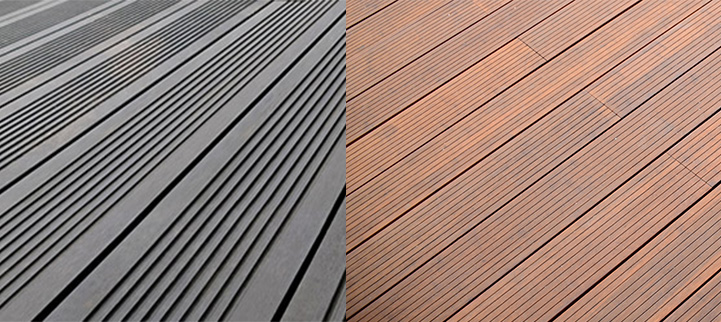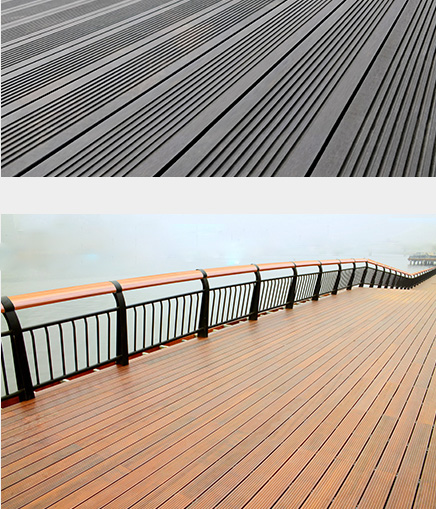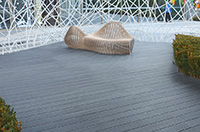Since the launch of the THJ High Carbonized Bamboo Decking, it has won wide market praise, THJ high carbonized Bamboo decking has proven to outperform any other bamboo decking. The millions of square meters of THJ bamboo decks installed around the world are the best proof. At the same time, the fact
Since the launch of the THJ High Carbonized Bamboo Decking, it has won wide market praise, THJ high carbonized Bamboo decking has proven to outperform any other bamboo decking. The millions of square meters of THJ bamboo decks installed around the world are the best proof. At the same time, the factory has been working on developing new technologies to find possible extensions. Subsequently, the Light Carbonized Bamboo Decking Board came into being.
Bamboo high carbonized decking or Bamboo light carbonized decking is chosen in most cases because it looks great and remains beautiful while also has excellent mechanical properties such as high density, durability and hardness. So what is the difference between high carbonized bamboo decking and light carbonzied bamboo decking?

1. The heat treatment process is different, high carbonzied bamboo decking is carbonized under the temperature of 200°C
2. As the name suggests, there is a difference in color between high carbonized and light carbonzied, high carbonized bamboo decking is a dark color, while light carbonized bamboo decking is a coffee color or caramel color, Both bamboo decking products are extremely hard and durable
3. High Carbonized Bamboo Decking equipped with a wider range of products allowing more design possibilities for a variety of profiles
Bamboo decking is a carbonized bamboo board under the temperature of 200°C
 The heat treatment of High Carbonized Bamboo Decking makes the material very stable.Through the deep carbonized anticorrosive technology patent, invented by THJ, the organic subst
The heat treatment of High Carbonized Bamboo Decking makes the material very stable.Through the deep carbonized anticorrosive technology patent, invented by THJ, the organic subst
ances which make the bamboo verminous and moldy be removed, which greatly remains the physical performance, solves the problem of being easy to go moldy and verminous and extends the performace life and applicability. Because there is no any added chemical in the processing, the enviroment-protection performance is more excellent.
The thermal treatment of Bamboo Light Carbonized has different ways of making fibers and pressing but its stability is the same. Moveover, Bamboo light carbonized decking is composed of over 90% bamboo and a few precent glue, which is also environmentally friendly just the same as Bamboo high carbonized decking. THJ outdoor bamboo decking as a eco-friendly material, which has been used as a quickly renewable and sustainable alternative for other building/decoration materials.
Both bamboo decking materials are extremely hard and durable
The raw material of bamboo is very strong and durable, The density of high carbonized bamboo decking is up to 1.12-1.15g/cm³and light carbonized decking reaches for 1.15-1.18g/cm³. Ensures an extremely dense and hard, therefore durable and sturdy decking board, which means a lifetime production life for THJ bamboo decking board. The high lifetime of the deck and its proven durability class 1 (according to EN 350:2016) through extensive testing demonstrate the durability of the decking board. The durability of High Carbonzied Bamboo Decking and Light Carbonzied Bamboo Decking is of the same high level.
Many design possibilities for bamboo decking , due to is stable
Bambo o decking board is very stable. Compared with hardwoods and many alternative materials, such as WPC, the shrinkage and swelling rate of bamboo material is larger. The high stability of the THJ bamboo decking ensures the boards can be stay for many years.
o decking board is very stable. Compared with hardwoods and many alternative materials, such as WPC, the shrinkage and swelling rate of bamboo material is larger. The high stability of the THJ bamboo decking ensures the boards can be stay for many years.
This stability is achieved through an extensive production process that converts bamboo fibers into boards. However, there are more different profiles available in the wider Bamboo Decking series, offering more possibilities for unique and interesting designs.
THJ Outdoor bamboo can be divided into high carbon bamboo, medium carbon bamboo and light carbon bamboo, the main purpose of carbonization is to remove sugar, prevent mildew and corrosion. After carbonization, the expansion coefficient will be reduced, and the small expansion coefficient will not easily deform and crack. The darker the carbonization, the darker the color (except for coloring), the deeper the carbonization, the worse the toughness. High carbonized bamboo has good flexibility, while high carbonized bamboo is more brittle.
